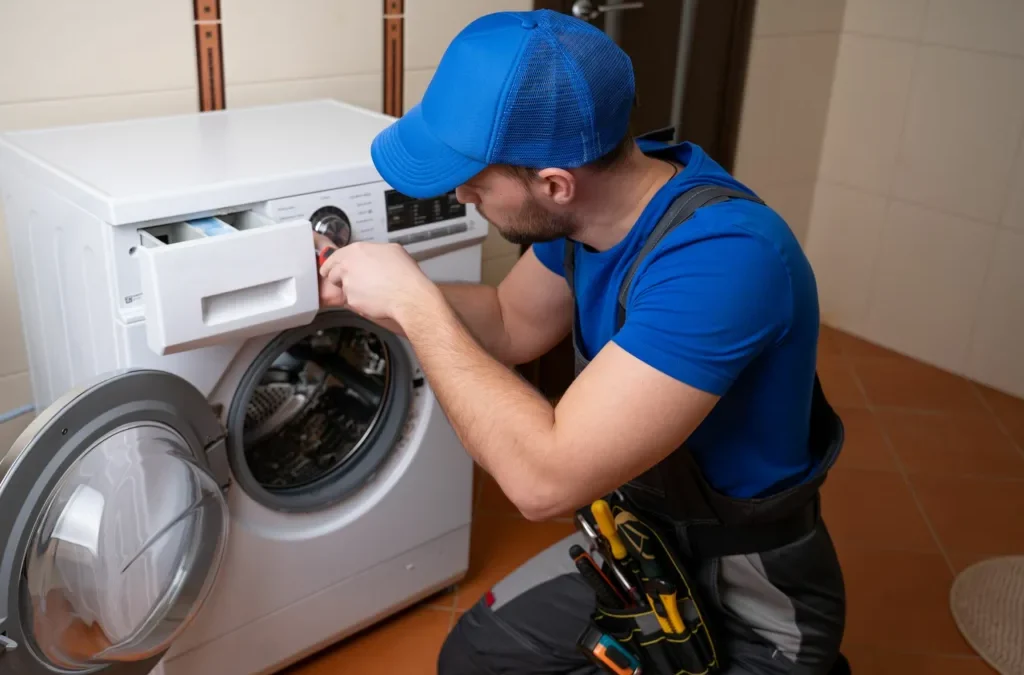The washing machine, a quiet stalwart in our homes, often goes unnoticed until something goes wrong. In a world where convenience reigns supreme, the simple act of tossing dirty clothes into a washer and receiving clean, fresh garments in return feels almost magical. But what happens when this magic falters? When the familiar hum turns into an alarming rattle, or when your clothes emerge still dripping wet? Suddenly, that dependable machine becomes a source of stress, leaving many homeowners bewildered and anxious.
While modern washing machines are engineered for durability and efficiency, they aren’t immune to wear and tear. Like all mechanical devices, they have their quirks and occasionally display symptoms of fatigue or malfunction. And just as a doctor might decipher the aches and pains of the human body, understanding the nuances of your washing machine’s behavior can be equally enlightening. Is the machine merely having an off day, or is it signaling a deeper issue?
For those unacquainted with the intricacies of washer mechanics, distinguishing between minor hiccups and significant problems can be daunting. The key, however, lies not in panic but in knowledge. A well-informed homeowner, equipped with insights into common washer problems and their potential solutions, is well-prepared to face any laundry day challenge.
In this guide, we delve deep into the world of washer repair. Drawing on expert advice and practical wisdom, we’ll demystify the most common issues that plague washing machines. Whether you’re a seasoned DIY enthusiast or someone who’s just trying to understand their appliance better, this exploration promises clarity and empowerment. So, let’s roll up our sleeves and decode the mysteries of washer problems, ensuring that every spin is as smooth as it was intended to be.
The Silent Spinner – Washer Doesn’t Start
Before diving into the more technical aspects of washer repair, it’s essential to address the basics. If your washer isn’t starting, ensure that:
- The door or lid is fully closed.
- The washer is plugged in, and the circuit breaker hasn’t tripped.
- The water supply valves are turned on.
If all these are in order, it might be an issue with the machine’s timer or control board. In such cases, it’s advisable to consult with a professional for washer repair.
The Overzealous Overflow – Water Leaking Issues
A puddle of water around your washing machine is never a good sign. This could be due to:
- Loose hoses: Ensure all hose connections are tight.
- Door seal issues: Inspect for wear and replace if necessary.
- Using too much detergent: This can cause excessive suds that can lead to leaks. Always follow the manufacturer’s guidelines.
The Lazy Agitator – Washer Doesn’t Agitate
When the washer fills with water but doesn’t agitate, it’s often an issue with the drive belt, lid switch, or motor. Here’s a quick rundown:
- Drive Belt: Over time, the belt can wear out or become loose. Inspecting and replacing it can resolve the agitation issue.
- Lid Switch: If the lid switch is faulty, it can prevent the washer from agitating or spinning. A simple replacement can usually fix this problem.
- Motor: If the motor burns out or has issues, it will need professional intervention for repair.
The Non-Draining Dilemma – Washer Doesn’t Drain
A washer that doesn’t drain can be quite the headache. This could be due to:
- Blockages: Check the drain hose for any obstructions. Ensure it’s not kinked or bent in a way that prevents water flow.
- Faulty Pump: The pump may have become defective or clogged with a small clothing item or debris. Inspection and cleaning or replacement might be necessary.
The Spinning Setback – Washer Doesn’t Spin
One of the most common washer repair concerns is when the machine doesn’t spin. Potential reasons include:
- Load Imbalance: If you’ve stuffed your washer with heavy garments, it might become imbalanced, preventing it from spinning. Redistribute the clothes evenly.
- Worn Drive Belt: Just as with agitation issues, a worn-out drive belt can prevent spinning. Check for signs of wear and consider replacing if necessary.
- Motor Coupler Issues: The motor coupler can wear out over time, leading to spinning problems. Replacement is often the solution.
The Rumbling Riddle – Washer Makes Loud Noises
No one wants a washer that sounds like it’s launching into space. Noise issues might stem from:
- Unbalanced Load: Make sure to distribute clothing evenly.
- Foreign Objects: Sometimes, loose coins, keys, or other objects can get inside the washer, causing noise. Check the drum for any foreign items.
- Worn Out Bearings or Belts: Over time, these parts can wear out, causing loud noises during cycles. Consider replacement if you suspect this is the cause.
Expert Tips for Maintaining a Smooth Spin
To ensure your washer’s longevity and smooth operation, here are some pro tips:
- Regular Inspection: Frequently inspect hoses for signs of wear, cracks, or bulges. Replace them every three to five years as part of routine washer repair and maintenance.
- Clean the Washer: Monthly cleaning with a washer cleaner or a mixture of vinegar and baking soda can help prevent mold and mildew buildup.
- Avoid Overloading: Always follow the manufacturer’s guidelines for load size. Overloading can wear out components faster and affect the machine’s efficiency.
Washer problems can be daunting, especially when you’re unfamiliar with the technicalities of the appliance. But by understanding the common issues and their solutions, you can tackle many problems confidently. Remember, when in doubt, it’s always a good idea to consult with a washer repair professional to ensure your machine’s longevity and optimal performance. Keep your washer spinning smoothly and enjoy hassle-free laundry days!
The Cold Conundrum – Washer Doesn’t Heat Water
An often overlooked but essential aspect of the washing cycle is the water temperature. If your washer isn’t heating water as it should, consider the following:
- Faulty Heating Element: Just like an electric kettle, washers use a heating element to warm the water. A malfunctioning element might be the culprit behind cold wash cycles.
- Thermostat Issues: The washer’s thermostat monitors and controls the water temperature. A defective thermostat might fail to signal the heater to turn on.
The Detergent Dilemma – Washer Not Dispensing Detergent
For sparkling clean clothes, the correct dispensation of detergent is crucial. If your washer isn’t dispensing detergent:
- Clogged Dispenser: Over time, detergent residue can accumulate and harden, leading to blockages. Regular cleaning can help prevent this issue.
- Faulty Dispenser Motor: If the motor responsible for dispensing is malfunctioning, it might need replacement.
The Odor Obstacle – Persistent Smells from the Washer
A persistent foul odor from your washer can make laundry an unpleasant chore. Here’s how to address it:
- Mold and Mildew: Standing water or a damp environment can promote mold growth. Running an empty hot water cycle with vinegar can help.
- Regular Cleaning: As mentioned earlier, monthly cleaning with appropriate products can keep odors at bay. Also, leave the washer door open after each cycle to allow it to air out.
The Shaky Scenario – Washer Vibrates Excessively
Excessive vibration can be more than just annoying; it can indicate a significant issue.
- Unlevelled Washer: Ensure your washing machine is on a level surface. Adjust the feet if necessary.
- Damaged Suspension Springs: If springs or dampening straps are worn out, they can cause the tub to become unbalanced, leading to vibrations. They might need replacement.
Preventive Measures: The Key to Prolonged Washer Life
The saying “prevention is better than cure” holds true for washer repair. By adopting a proactive approach:
- Regularly Check the User Manual: Your washer’s manual is a treasure trove of information. Familiarize yourself with recommended maintenance routines.
- Use Quality Detergent: Low-quality detergents can leave residues, affecting the machine’s efficiency. Opt for recognized brands and the correct type for your washer (HE for high-efficiency washers).
- Avoid DIY When Uncertain: If you’re unsure about a particular repair, it’s wise to call in the experts. Improper DIY can sometimes exacerbate issues.
Conclusion
In the vast realm of household appliances, the washer stands out as one of the most used and appreciated. When it runs smoothly, it’s easy to take its operation for granted. However, like any appliance, it can have its off days. Equipped with the knowledge from this guide, you can now approach most washer repair issues with newfound confidence. Still, when faced with a particularly challenging problem or when in doubt, there’s no shame in seeking professional help. In Hesperia, MI, the team at Affordable Appliance Repair of West Michigan stands as a trusted service provider, known for their expertise and dedication. You can reach out to them at (231) 854-2377 for prompt and reliable service. Your clothes, and your sanity, will thank you!

